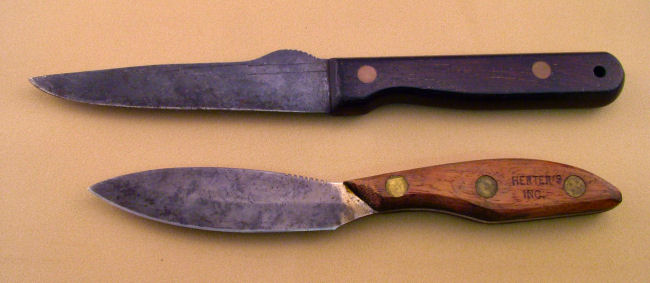George Herter ran an old-timey sporting goods store out of Mitchell S.D. It was quite an operation in its day (similar to Cabelas) but for whatever reason declined in the late 70s.
I don't think the word modest could be used to describe George. He was also quite a salesman and could hawk a product like nobodys business. One of the books George wrote was called "Professional Guide's Manual," written for the North Star Guide Association (which probably did not even exist). There are a lot of wonderful outdoor tips in the book (or books-lots of versions out there) about hunting and fishing, along with a lot of his self-promotion and sales pitches. I learned how to clean a squirrel from this book and I cured some stomach problems I once had using a tip from this book.
One section, How to Buy an Outdoor Knife I thought might be interesting for this discussion on bushcraft knives.

Perhaps some thoughts outside the woodlore box.

How to Buy an Outdoor Knife by George Leonard Herter
An outdoor knife must be made for service--not show. Your life may depend on it. Real outdoor people realize that so-called sportsmen or outdoor knives have long been made for sale, not for use. The movies and television show their characters wearing fancy sheath knives. Knife makers advertised them and drugstore outdoorsmen bought them. Nothing marks a man to be a tenderfoot more than these showy useless knives.
Here are some of the duties a true woodsman knife must perform:
1. The knife must stay sharp for long periods of time without shapening. The steel should combine the best characteristics of electric furnace quality high carbon 1095 steel and high carbon 440 B stainless steel. The blade hardness, known among steel experts as 56 Rockwell C, should not be affected by atmospheric moisture, salt spray, fruit acids or blood. It should withstand extreme temperatures without becoming brittle, no matter how cold it may be. A good steel knife blade will "blue" or darken itself with use, making it pratically rustproof. If knife blade steel is really good, it will cut through nails without bending over the edge.
2. The knife must be shaped so it is ideal for cleaning and skinning game of all kinds, from rabbits to moose. The best shape for this is the improved Bowie.
3. The knife must have a handle long enough so that it fits a man's hand so pressure can be put on the blade when desired. On nearly all outdoor knives the handles are much too short. The handle of the knife must be made to last a lifetime. Leather handles rot and mildew, stag handles crack, plastic handles crack and are highly inflammable. African mineral-type woods are best, and they will stand all kinds of weather for a lifetime and more.
4. The blade of the knife must not be hollow ground. Hollow grinding weakens a blade so that the edge will bend or break under heavy usage. A wedge edge is the strongest and most durable ever designed.
5. The blade of the knife must be hand forged in order to give the steel maximum strength and hardness.
6. The blade of the knife must not have a blood groove. A blood groove is strictly advertising and badly weakens the blade. Professional butchers do not use them.
7. The knife must be easy to carry and light in weight. The blade length must be 4 inches long. Four inches is the length established for a woodsman knife by over 200 years of experience. Blades shorter are all right for Boy Scouts, but not for serious woodsmen, Longer than 4 inches is unnecessary and adds weight.
8. The knife should have no hilt as it only adds weight. If the knife blade is properly designed, that is slightly indented, you cannot cut your finger no matter how hard you thrust. You need only thrust in a hand to hand combat with a man or a wounded animal.
9. The knife must be capable of slicing bacon and cutting bread. It must be a comfortable knife for eating and cutting cooked meat.
I dislike seeming prejudiced but the George L. Herter knife made by Herter's is and has been the choice of real outdoor people.
*******************
The top knife is Herters Improved Bowie, the bottom knife is the George L. Herter knife, which should look familiar to a lot of folks here.



